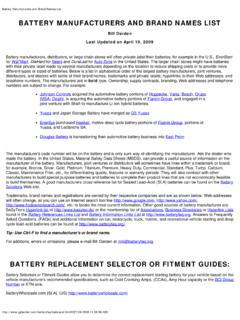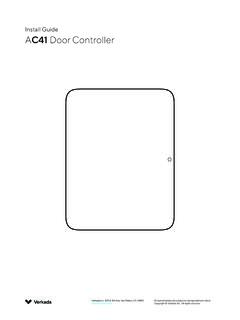Transcription of The Clean Vehicle Retrofit Technology Guide
1 The Clean Vehicle Retrofit Technology Guide Date of Report: March 2021. Acknowledgements The production of Clean Vehicle Retrofit Guide has been sponsored by the following organisations: Project Team: Daniel Hayes - Project Manager Gloria Esposito - Head of Projects Author: Daniel Hayes Reviewed by: Gloria Esposito This Guide has been prepared by Zemo Partnership Zemo Partnership 3 Birdcage Walk, London, SW1H 9JJ. T: +44 (0)20 7304 6880. E: Visit: 1. @Zemo_org Zemo Contents 1 Introduction 4. UK Air Quality Policy 4. National Retrofit Technology Programmes 7. Funding Streams for Retrofit Technologies 8. 2 Clean Vehicle Retrofit Accreditation Scheme 9. What is CVRAS and what Vehicle types and technologies does it cover? 9. Technology Accreditation 9. Vehicle Emissions Limits 10. In-Service Monitoring 10. Company Approval 11. Registering a Retrofit System 11. 3 Vehicle Retrofit Technologies 12. Selective Catalytic Reduction 12.
2 Repower: Heavy Duty Euro VI certified engine 17. Repower: Battery Electric Powertrain 22. Repower: Euro 6 LPG 26. 4 Reducing GHG emissions 29. Renewable Diesel 29. HVO 29. Renewable Electricity 29. Telematics 29. Appendix 30. Retrofit Providers & Further information 30. CVRAS Approved Technology Suppliers 30. Technology Suppliers 31. Approved Installers 31. List of Abbreviations CVRAS Clean Vehicle Retrofit Accreditation Scheme Defra Department for Environment, Food and Rural Affairs DfT Department for Transport JAQU Joint Air Quality Unit (Defra + DfT). TfL Transport for London NOx Oxides of Nitrogen (NO, NO2). PM Particulate Matter N2O Nitrous Oxide NO2 Nitrogen Dioxide NO Nitric Oxide CVTF Clean Vehicle Technology Fund CBTF Clean Bus Technology Fund ULEZ Ultra Low Emission Zone LEZ Low Emission Zone HGVs Heavy Goods Vehicles RCVs Refuse Collection Vehicle GHG Greenhouse Gas PEMS Portable Emissions Measurement System EST Energy Savings Trust Zemo Zemo Partnership BEAR 1/2 Bus Emissions Abatement Retrofit (Programme).
3 HVO Hydrogenated Vegetable Oil BioLPG Bio Liquid Petroleum Gas The Clean Vehicle Retrofit Technology Guide 1. Introduction The Clean Vehicle Retrofit Technology Guide aims to provide Vehicle operators and local authorities with an understanding of national air quality frameworks for reducing roadside NO2 concentrations, providing case studies with examples of a range of accredited Retrofit technologies that achieve Euro VI equivalent levels of emissions through the Clean Vehicle Retrofit Accreditation Scheme (CVRAS). The Guide covers technologies accredited for bus, coach, truck, refuse collection vehicles and black cabs, with solutions for vans and cars a possibility in the future. There is a significant air quality challenge currently The purpose of the accreditation scheme is to provide facing UK cities, towns and the strategic road network, confidence to operators that a system meets set with an estimated 40,000 early deaths caused by poor emissions limits and will continue to perform in- air quality.
4 The Department for Environment, Food and service. Only robust, proven Retrofit technologies that Rural Affairs (Defra) commissioned research estimated achieve equivalent emission targets and in- service that poor air quality had cost up to in reduced performance equivalent to Euro VI/6 vehicles will productivity in the UK in 2012 (Ricardo-AEA, 2014). achieve CVRAS accreditation. CVRAS approved companies must also meet set requirements in The two pollutants of most concern are particulate terms of their legal status, financial stability, quality matter (PM) and nitrogen dioxide (NO2), with local management, warranty and insurance provision. concentration levels of NO2 exceeding mandated EU. limit values. A significant proportion (78%) of roadside UK Air Quality Policy NOx (NO and NO2) originates directly from road transport, with diesel vehicles responsible for 90+% of The CVRAS accreditation scheme has been NOx emissions, averaged across the country (Figure 1).
5 Incorporated into a range of strategies, policies and funding streams developed across the UK by national Transport services like buses and taxis are and local governments, with approved retrofits already overwhelmingly powered by diesel engines and their in-service in many cities helping to reduce harmful high mileage in urban areas often means that non-Euro air pollutants from transport. in a number of areas VI / 6 diesel vehicles can be key contributors to local across the UK. The table below describes the targets roadside NO2 (Figure 2). for NO2, which is measured using roadside emissions monitoring stations. CVRAS accredits Retrofit technologies that reduce air pollutants from existing vehicles to levels equivalent to Euro 6 (light duty) or Euro VI (heavy duty) standards. Figure 1: Breakdown of average roadside sources of NOx emissions by Vehicle type. (NAIE, 2018). Petrol Motorcycle & Moped Diesel HGVs Petrol Cars Diesel Bus and Coach Diesel Cars Diesel Vans Petrol Vans 4.
6 The Clean Vehicle Retrofit Technology Guide Clean Air Zones in England Table 1. The minimum emission standards for charging Clean air zones In July 2017 the Government published the UK plan for tackling roadside NO2 concentrations , which originally Vehicle Type Minimum emission standard required local authorities in areas expected to exceed the European Union (EU) NO2 limit values beyond the Buses and coaches Diesel Euro VI. next three or four years to develop innovative local plans that will achieve statutory NO2 limit values within HGVs Diesel Euro VI. the 'shortest possible time . The plan sets out charging Clean Air Zone (CAZ) schemes as one measure to Vans Euro 6 (diesel) Euro 4 (petrol/LPG). achieve statutory NO2 limit values in towns and cities in Taxis and private the shortest possible time. hire vehicles Euro 6 (diesel) Euro 4 (petrol/LPG). A CAZ defines an area where targeted action is taken Cars Euro 6 (diesel) Euro 4 (petrol/LPG).
7 To improve air quality and resources are prioritised and coordinated in order to shape the urban environment Motorcycles and Euro 3. in a way that delivers improved health benefits and mopeds supports economic growth . There are two types of CAZ: Table 2. Charging Clean air zone classes Non-charging CAZ: Involves a range of actions to improve air quality including (but not limited to) Charging CAZ. Vehicles potentially included voluntary targets for fleet renewal and Retrofit of non- Class Euro VI vehicles; measures to encourage the use of Buses, coaches, taxis and private public transport; walking and cycling; the uptake of A. hire vehicles ULEVs or road layout changes at congestion and air pollution pinch points'. Buses, coaches, heavy goods B vehicles (HGVs) taxis and private Charging CAZ: In additional to the above, Vehicle hire vehicles owners are required to pay a charge to enter or move within a zone if they are driving a Vehicle that does not Buses, coaches, HGVs, large vans, mini buses, small vans/light meet the particular standard for their Vehicle type in C.
8 Commercials, taxis and private hire that zone. Under the CAZ Framework for England, vehicles charging CAZ are sub-divided into classes A \ D on the basis of the types of vehicles to which the Buses, coaches, HGVs, large charging schemes apply (Table 2) vans, mini buses, small vans/light D commercials, taxis and private hire vehicles, cars, motorcycles and Vehicles which meet the minimum European emission mopeds . standards for these zones, including through fitment of approved CVRAS Retrofit technologies, will be able to enter or move within the zone without being charged (Table 1). Ultra-Low Emission Vehicles will also be able to enter or move within zones without charge. Figure 2: Relationship between tailpipe NOx and roadside NO2 from internal combustion engines NO. NOx Roadside NO2. NO2. Primary NO2. Reacts in air to form secondary NO2. 5. The Clean Vehicle Retrofit Technology Guide At the time of publication, Bath and Birmingham vehicles from entering a CAZ or charging them to enter.
9 Will introduce charging Clean Air Zones (CAZ C & D In November 2018, the Welsh Government published a respectively) in 2021, with Manchester, Portsmouth and supplement to the UK plan for tackling roadside NO2. Newcastle considering the introduction of charging CAZ. concentrations. A 20m air quality fund, which will Where vehicles do not meet the minimum emissions run until 2021, will be provided to support Cardiff and standards, they will be charged to enter. Charges Caerphilly councils comply with NO2 concentration for access to different CAZs are set at a local level limits in the shortest possible time and cover the cost and may differ for the same Vehicle class across the of feasibility studies to assess the impact of introducing country. Clean Air Zones. A national Vehicle checker is being developed to enable Low Emission Zones in Scotland drivers to find out if their Vehicle will be subject to The Scottish Government outlined plans for four Low charge in Clean Air Zones: Emission Zones (LEZ) to address air quality issues in the country to be in place by 2020 in the Scottish Governments' Programme for Government 2017/18, with Vehicles retrofitted with CVRAS approved technologies the first LEZ launched in Glasgow at the end of 2018.
10 Will not be subject to charge for entering charging CAZ. A crucial distinction between LEZs in Scotland and CAZ. Ultra-Low Emission Zone in London elsewhere is that vehicles cannot pay to access the London has introduced the equivalent of a CAZ Class LEZs. Non-compliant vehicles will receive a penalty D in the form of the Ultra Low Emission Zone (ULEZ) charge if they enter the zone, similar to that of a parking on 8th April 2019, which will be the same area as the fine. Scottish LEZs require the same emission standards current Congestion Charge zone. There will be a charge for vehicles as Clean Air Zones and London's ULEZ. to enter the zone of per day for non-compliant Vehicles retrofitted with CVRAS approved technologies cars, vans and motorcycles and 100 per day for non- will not receive a penalty charge for entering LEZs. compliant heavy duty vehicles. In addition to Glasgow, LEZs are also expected to be On March 1st 2021, ULEZ requirements for Euro VI heavy established in Edinburgh, Aberdeen and Dundee.



